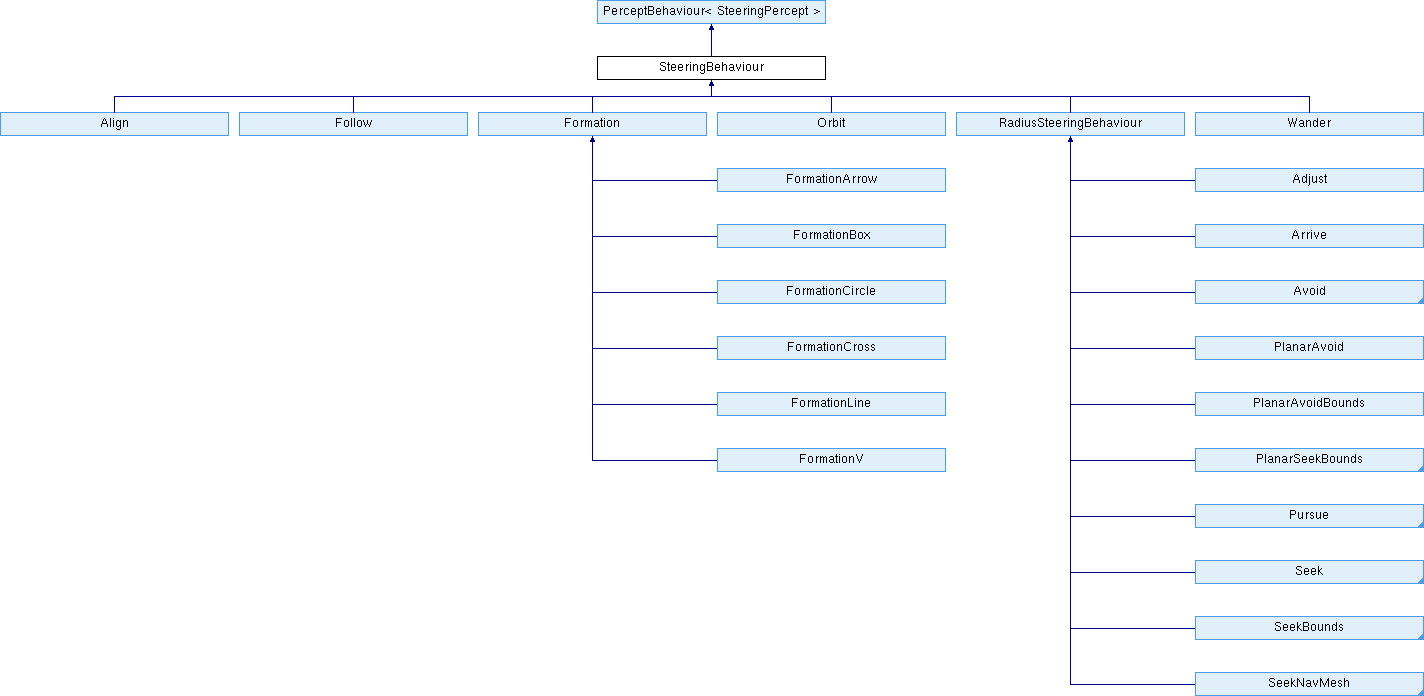SteeringBehaviour provides the base functionality for writing and mapping objective values (back-end class).
This derived PerceptBehaviour<T> is the very foundation for all context steering algorithms. The objective values are written into an associated Context.Problem which is evaluated in Context.Evaluate based on the inherited PerceptBehaviour<T>.Percepts and PerceptBehaviour<T>.Self. In order to obtain and write objective values, the three methods StartSteering, PerceptSteering and ReceptorSteering are used for setting up an appropriate ResultDirection and ResultMagnitude, whereby the switches ValueMapping and ValueWriting determine how objective values are written. In addition, with the help of VectorProjection it is possible to project the perceived vector data which are necessary for obtaining objective values into a specified plane. This might be useful, for example, when there is a (virtual) ground and height map in the world, so this is always the case when the scene objects differ significantly in height.
Every derived SteeringBehaviour needs to implement the properties forEachPercept and forEachReceptor to determine if the corresponding methods PerceptSteering and ReceptorSteering are called within Behave. Usually, you might only want either PerceptSteering or ReceptorSteering to be called at once.
A SteeringBehaviour can be marked as thread-safe in its corresponding front-end class through setting AIMBehaviour.ThreadSafe to true. If you do this, be sure not to use reference types of the Unity scripting API and not to make any possibly unsafe variable writes. If at least one behaviour is not marked AIMBehaviour.ThreadSafe, the whole agent will not be part of the multithreading (Pro only).
Base back-end class of every derived AIMSteeringBehaviour.

Public Fields | |
| Vector3 | ResultDirection |
| The direction vector used for obtaining objective values. More... | |
| float | ResultMagnitude |
| The magnitude value used for obtaining objective values. More... | |
| int | TargetObjective |
| Defines the objective for writing values. More... | |
| float | MagnitudeMultiplier = 1f |
| Is multiplied to the ResultMagnitude in order to weight between different behaviours. More... | |
| float | SensitivityOffset |
| Is added to the Structure.Sensitivity as threshold for writing objective values. More... | |
| ValueWritingType | ValueWriting = ValueWritingType.AssignGreater |
| Sets the type for writing objective values. More... | |
| LayerBlendingType | LayerBlending = LayerBlendingType.None |
| Sets the operation for blending the behaviour results into the context. More... | |
| LayerNormalizationType | LayerNormalization = LayerNormalizationType.None |
| Sets the method for normalizing intermediate objective values while they are blended into the context. More... | |
| MappingType | ValueMapping = MappingType.InverseLinear |
| Sets the mapping type for obtaining objective values. More... | |
| bool | UseSignificance = true |
| Determines if the SteeringPercept.Significance (if there is a AIMSteeringTag) is multiplied to the ResultMagnitude in order to weight between different percepts. More... | |
| bool | UseSensorProjection = true |
If true, Sensor.ProjectionMode is used as VectorProjection. More... | |
| VectorProjectionType | VectorProjection = VectorProjectionType.None |
| Sets the type for projecting the perceived vector data into a plane. More... | |
| PresetVelocityType | PresetVelocity = PresetVelocityType.None |
| If the value is anything other than PresetVelocityType.None, a game object's rotation and default forward direction is used to approximate its actual velocity. More... | |
| PredictionType | Prediction = PredictionType.None |
| If set to anything other than PredictionType.None, the position of the Self percept is updated according to the given velocity. More... | |
| float | PredictionMagnitude = 0.0f |
| Scales the velocity vector used for predicting the possible future position of an agent if Prediction is set to PredictionType.PredictionMagnitude. More... | |
| readonly IList< T > | Percepts |
| All percepts which are relevant for an agent. More... | |
Protected Fields | |
| readonly SteeringPercept | self = new SteeringPercept() |
| The data of the associated agent itself (read only). More... | |
| readonly SteeringPercept | percept = new SteeringPercept() |
| The data of the currently processed percept (read only). More... | |
| IList< float > | objective |
| Quick access to the currently processed objective. More... | |
| ISensor< Structure > | sensor |
| Quick access to the currently processed sensor. More... | |
| IReceptor< Structure > | receptor |
| Quick access to the currently processed receptor. More... | |
| Structure | structure |
| Quick access to the currently processed structure. More... | |
| Vector3 | velocity = Vector3.forward |
| The forward direction the agent moves towards and/or looks at by default. More... | |
Properties | |
| abstract bool | forEachPercept [get] |
| Determines if PerceptSteering is called within Behave (read only). More... | |
| abstract bool | forEachReceptor [get] |
| Determines if ReceptorSteering is called within Behave (read only). More... | |
| override SteeringPercept | Self [get, set] |
| The data of the associated agent itself. More... | |
Public Methods | |
| override void | Behave () |
| This method executes the main context steering algorithm and is called within Context.Evaluate in order to set/modify objective values for the associated Context.Problem. More... | |
Protected Methods | |
| virtual bool | StartSteering () |
| Gets called at the beginning of the context steering algorithm for each processed percept and should be used to pre-compute things like distances or to check whether a percept is relevant at all. More... | |
| virtual void | PerceptSteering () |
| This method gets called once for each processed percept. More... | |
| virtual void | ReceptorSteering () |
| This method gets called for each active shape receptor for each processed percept. More... | |